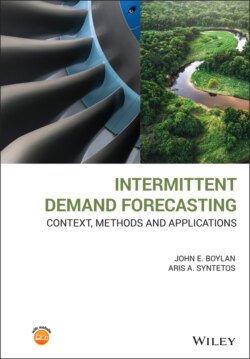Читать книгу Intermittent Demand Forecasting - John E. Boylan - Страница 50
2.5.2 Periodic Review Systems
ОглавлениеIn periodic review systems, the inventory decision rules most usually take the form of a or policy, the former being the one to be discussed in more detail in this book. Under the regime of both policies, after every periods (constant inventory review interval) enough is ordered to raise the inventory position up to the ‘order‐up‐to level’, . The difference between the two policies is that the policy requires the inventory position to be less than or equal to (or in certain cases strictly less than ) before an order is placed. Therefore, the policy always results in higher ordering costs because even a unit‐sized transaction during the review interval will trigger a replenishment requisition, whilst the policy will place an order only if the cumulative demand, over the review interval, exceeds some minimum level. The can be viewed as the periodic implementation of the system because the reduces to for .
Figure 2.4 Periodic review policy.
In Figure 2.4, we show graphically the operation of the policy. For ease of presentation, we assume that no stockouts occur (i.e. backordered demand does not need to be accounted for). We further assume that the review interval is shorter than the lead time (as is typically the case in practice in wholesaling), i.e. . In particular, we assume that .
At time , the inventory position (which is assumed to be, for presentation purposes, at that point in time equal to the stock on hand (SOH)) is compared with the OUT level and enough is ordered to raise it up to that level. Once the order has been placed, then the inventory position equals and decreases thereafter in exactly the same way as the stock on hand. At time , the stock on hand has been further depleted and the quantity ordered at is the stock on order; the inventory position is contrasted again to and is raised up to that level. At time , the order placed at is received and added to the stock on hand; the order placed at is the stock on order and the inventory position is raised again up to .
The system depicted in Figure 2.4 is based on a fixed OUT level, , that does not change over time. The same is true for the control parameters , , and in Figure 2.3. Although it is actually common practice in industry for the control parameters to be fixed over long periods of time, more responsive inventory systems rely upon an update at each stock review occasion. So, for the system, the OUT level would be updated at every time interval . This issue is discussed further later in this chapter.
With regard to the review interval, for both and systems, this can be either optimised or, as most often happens in practice, set to be equal to a convenient time unit. The review interval can be optimised by classical economic lot size computations. The expected time over which the economic order quantity (EOQ) will be demanded is used to determine the review interval, (see, for example, Brown 1982). Alternatively, may be set to a standard time unit such as, for example, half a day for a retailer, a week for a wholesaler, or a month for a manufacturer. The inventory review interval is usually decided by taking into account such factors as the nature of the business (the higher the volume of business the shorter the review interval will be to facilitate control), the lead times (if the lead time is one day it would not make much sense to set the review interval to one month), and inventory software related constraints. There is little guidance in the academic literature on setting appropriate inventory review intervals. Nevertheless, we remark that the forecast update interval is typically set to be equal to the inventory review interval, and this makes sense from a practical perspective.
As previously discussed, one may question the practical relevance of continuous review when most inventory control systems seem to be relying upon some sort of periodic review. However, continuous systems tend to be easier to analyse mathematically. In addition, as the review interval becomes shorter and shorter, periodic formulations become hard to distinguish from continuous ones. For daily or even half‐daily review intervals commonly used by retailers, the continuous assumption is a reasonable one (e.g. Cattani et al. 2011).
Fixing the inventory review interval to be the same for a number of SKUs facilitates their collective replenishment from a common supplier, and introduces some stability in the inventory and purchasing organisational functions. We do not mean to imply here that all periodic inventory control systems are necessarily easy to implement, but in an intermittent demand context at least, where we deal with very high numbers of items, these are more realistic than continuous policies. In the subsections to follow, the literature on periodic inventory control for intermittent demand items is summarised and the main approaches to managing intermittent demand stocks are discussed.
